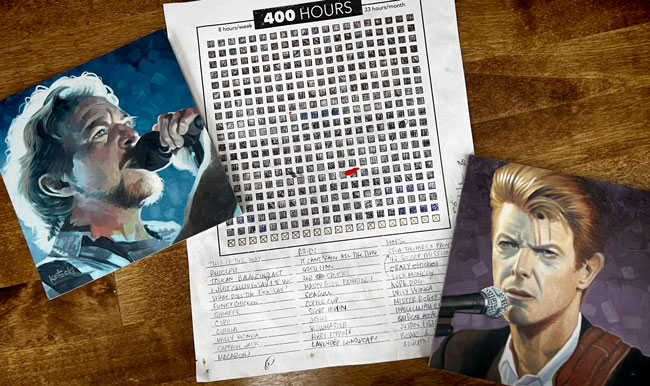
At the beginning of 2022, I set a goal of achieving 400 studio hours. It was born out of a retreat I had a month earlier in which I felt God telling me to spend less time doing His job and more time doing mine. It was made clear to me that a big part of my job included making art. I figured an average of 8 hours a week was worthy of aiming for.
After starting out of the gate strong, I hit a speed bump when we went on vacation to Florida at the end of January. Missing a whole week required me to squeeze in those eight hours elsewhere. It took me till the end of February to get caught up.
Things went off the rails again in June, when a one-hundred-per-hour straight-line wind ripped through our backyard and upended our life for the next few months. In the meantime, we were busy preparing for our first out-of-state Escape Adulthood Summit, leading to another week out of the studio while in Utah.
Despite the challenges, I kept chipping away, painting in the living room and at the kitchen table while my studio was being renovated. I was filling in boxes on my homemade chart, one by one, slowly but surely.
As we rolled into December, I could taste it. I was several weeks behind, but 400 was still doable. It would require some late nights and weekend effort, but it was possible.
And then…I decided to let it go.
It was not an easy decision, but something had to give. All three of our kids’ birthdays are between Thanksgiving and Christmas, and the addition of hosting a piano recital and the usual holiday preparations had me overwhelmed.
The thought of giving up on 400 hours surfaced, but I didn’t want to give it any oxygen.
Sure, the number itself was completely arbitrary. And yes, when I came up with it, I forgot to factor in simple things like taking vacations. In fact, I remember 380 hours feeling more realistic at the time, but it didn’t have the same ring to it as 400, so I went the route of an overachiever!
All that said, I am no quitter. A lot of people knew I was working toward this goal. I didn’t want to publicly admit defeat, and I didn’t want to fall prey to the easy rationalizations we are so quick to conjure when we find the road harder than we expected.
On the other hand, I was getting stressed out. I was worn down from a very difficult year. I wasn’t enjoying the family time because I saw it as a distraction from achieving my goal.
Finally, I asked myself the most important question: Why?
Why did I set this goal in the first place?
The reason was simple: to make studio time a priority. To make sure I was making art. It’s my favorite thing to do, but easy to put off for more “urgent” things. (Pro tip: urgent things are rarely the most important things.)
The thing is, it worked. I persisted amidst the distractions of the storm and the displacement of having no consistent place to work. I was prolific, creating more art than I’d made in years. But the hard truth was that somewhere along the line, I had made the goal a god.
The goal was no longer serving me, I was serving it.
My intentions had become polluted. Achieving the goal was more about my pride. The process was poisoning my health, my relationships, and my love of art.
And so, after much deliberation and prayer, I decided to forgo the final row on my scoreboard, crossing off the boxes in gold ink, designating them as an offering of sorts.
My pride took a hit but my spirits lifted. It still required intentionality to reach 380, which I did on New Year’s Eve.
So that’s it. That’s my confession, an admission of failure that I consider a success.
Maybe there is a lesson here that is useful to you.
I hope it’s not permission to give up too soon on something that matters to you, but perhaps an encouragement to give yourself grace, and peace to know it’s ok to pivot when plans change or you gain new information.
More than anything else, it’s a reminder to keep that most valuable of questions –– why? –– at the ready.
Why did I set this goal?
Why did I make this choice?
Why did I start this thing in the first place?
A question that starts with “why” is a great prescription for clarity.
And it helps keep us on the right track, making sure our goals serve us, not the other way around.